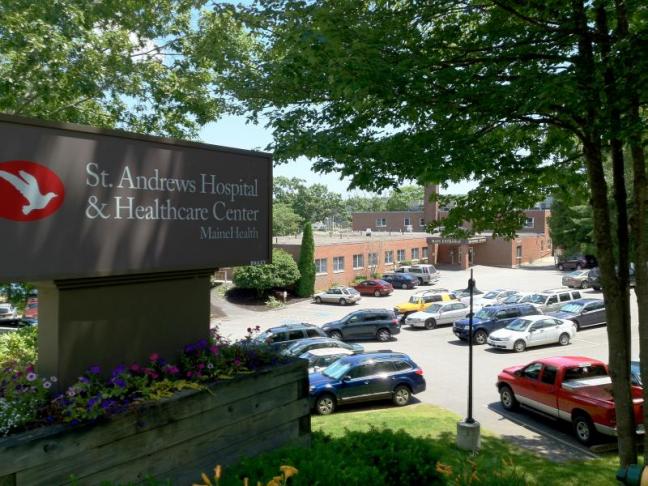A community waits
St. Andrews Hospital in Boothbay Harbor has held a special place in this region for more than 100 years. Its history tells a story of a devoted community, of regular outpourings of charity and, like any history, it has been marked both by the occasional controversy and constant change.
For several months, we've known changes are coming at the hospital. In the next few days, the community will learn what the future holds.
Rumors have flown. Fears have surfaced at selectmen’s meetings, on Facebook, and at public and private gatherings. A community that is accustomed to voting on everything from the town manager’s salary to the public works department’s paving budget feels strangely isolated from a decision-making process that will affect them greatly.
Lincoln County Healthcare, the group that manages both St. Andrews and Miles Memorial Hospital in Damariscotta, has promised a full explanation of proposed clinical changes this week. Until then, the community waits.
In the weeks following the announcement, the Boothbay Register will feature a series of articles exploring these changes at St. Andrews Hospital and their meaning to the community that relies on it, staffs it and supports it.
A look back
This isn't the first time St. Andrews has been at the center of change.
St. Andrews’ early years marked the end of an era. It was part of the rise of hospitals as centers for healing and the end of house calls, home births and kitchen operations. St. Andrews, like every other hospital in this country, has seen the ascent of technology and the depersonalization of medicine – of healing as business, of computers and machines as diagnosticians. It has also seen science and medicine conquer disease and extend lives.
St. Andrews has also mirrored the economy over time. The flush years of the 1980s and 2000s saw building booms. Now, in the midst of a national recession, St. Andrews, like so many other institutions, is making cuts.
Over the years, St. Andrews Hospital has been able to hold onto the personal in a way that larger hospitals have not. It is a characteristic that residents hold dear and one they do not wish to lose.
St. Andrews’ beginnings rival a good novel. A young Dr. George Gregory arrives from away and establishes the Gregory Sanatorium on the shore of Mill Cove in 1908. Five years later, in recognition of the community he serves, Gregory renames his hospital to honor St. Andrew, the patron saint of fishermen. For many years, Gregory and his crew of nurses live in the hospital. Patients come and go at all hours; the staff is always on call.
Gregory served as physician and administrator until his death in 1946, then his son, Dr. Phillip Gregory, took over the family business.
In 1952, St. Andrews Auxiliary was born and for the next 60 years, this dedicated crew of women did everything from rolling bandages to answering phones. Always they raised money to buy equipment and keep the hospital afloat. The Auxiliary started its thrift shop – now as much an institution here as the hospital itself – in 1976. They have raised well over $1 million over the years – all of it used exclusively for this community’s health.
In 1955, St. Andrews Hospital transitioned from a privately owned hospital to a nonprofit community hospital. Phillip Gregory continued to serve as administrator and physician for the next 20 years.
The next 40 years saw radical improvements in infrastructure, technology and programs. Doctors came and went, but some, like Drs. John Andrews and Andre Benoit, came and stayed.
In 1959, a new 30-bed facility was built. Half of the $910,000 cost was raised locally. In its first year in the new building, St. Andrews hospital served 809 patients, delivered 98 babies and saw 2,253 outpatients in its clinic. The hospital operated at a loss of $2,510.
In 1980, an emergency department was added and home health services began again in 1984. In 1987, with 2.3 million local dollars, a new acute care wing opened with 22 beds, including two birthing rooms and a nursery. St. Andrews Clinic was expanded and reopened as the Family Care Center in 1994. In 1998, the School Health Center opened and the hospital broke ground on St. Andrews Village, which opened in 2000.
In 2002, another major renovation and expansion project was undertaken at St. Andrews; the local capital campaign raised $6.5 million. Renovations included expansions to surgery, the emergency department, the laboratory and diagnostic imaging centers, as well as mechanical and electrical improvements. In 2007, the new Family Care Center opened.
Changes have not been limited to buildings and equipment. Over the years, there have been clinical, financial and administrative changes, and changes in patient use, as well. Renovations in 1987 and 2004 brought vast improvements, but increased facility use has not always accompanied these improvements.
By the early 1990s, babies were no longer delivered at St. Andrews Hospital and by 2010, surgery and acute care inpatient programs had ended. An oncology program lasted from 1997 to 1999, and this last spring, outpatient surgery, which consisted mainly of endoscopies, ceased.
Despite improved facilities, patient volumes dropped over time at St. Andrews, as patients increasingly chose larger medical centers with specialists and lower costs.
Making ends meet
It seems that struggling to maintain the hospital's financial health has been a constant through the years.
St. Andrews has not only been reliant on donations, it has also always been a benefactor, providing healthcare whether patients could pay or not. Free care at St. Andrews amounted to $211,607 in fiscal year 2007; in fiscal year 2012, the hospital’s free care is projected to top $496,000.
A shift to Medicare and Medicaid as primary payers – neither program reimburses hospitals for the full cost of care – has further tipped the financial scales in recent years. In 1959, 70 percent of St. Andrews’ patients were covered by insurance. In 2011, 70 percent of patients at St. Andrews were covered by Medicare or Medicaid programs and only 21 percent by private insurers.
Nationwide over the last 30 years, hospitals began to band together to improve buying power, reduce costs through consolidation and gain staff expertise. In 1997, St. Andrews was the first hospital to join MaineHealth, now the largest family of healthcare providers in the state.
Joining MaineHealth doesn’t seem to have riled residents here, but proposals to affiliate with Miles Memorial Hospital certainly did.
As early as 1986, the St. Andrews Board of Trustees was considering a joint management structure to govern both St. Andrews and Miles Memorial Hospitals. In 1987, St. Andrews Administrator Shirley Davison resigned over the possible affiliation, citing secret meetings. Employees and community members voiced concerns that affiliation would cause services at St. Andrews to be displaced to Miles. For some, that concern still exists.
Despite the controversy, by 2000 Miles and St. Andrews had consolidated their financial and information services programs. In 2008, Lincoln County Healthcare, a joint governance and management structure for St. Andrews and Miles Memorial Hospitals and attendant healthcare facilities, was created.
With the formation of Lincoln County Healthcare, its CEO Jim Donovan was tasked with streamlining management and reducing costs; Donovan said in a recent interview that the changes he has instituted to date have resulted in $3 million in annual savings.
These savings have not been realized without costs to Lincoln County Healthcare’s personnel and programs. In May 2010, 11 full-time positions were eliminated, including three employee layoffs. For the remainder of that fiscal year (ending Sept. 30), wages were frozen, vacation time was reduced and the base contribution to employees’ pension funds was suspended.
In April 2012, Lincoln County Healthcare terminated 14.6 full-time positions, including four layoffs, eliminated one pay period of earned-time for all employees and suspended outpatient surgery at St. Andrews Hospital. At the time, Donovan said these cuts were made in response to budget shortfalls resulting from decreased patient volumes, increased free care and shortfalls in Medicaid and Medicare reimbursements. He also said the Board was evaluating the need for additional changes in clinical programs.
More change to come
Over the last month, local communities have waited anxiously to hear what those clinical changes will be. The anxiety is two-fold because Lincoln County Healthcare not only provides health services to the region, it is the county’s number one employer.
On July 27, Donovan explained his and the Board’s silence on upcoming changes in an email to local town managers: “For the past six months, our Board of Trustees, medical staff, and management have carefully worked out a strategy that we believe will help maintain the quality of and access to care we provide and our financial viability in the future. Because this plan involves a change in some (not all) clinical services provided at St. Andrews, we must have the MaineHealth Board of Trustees’ approval to proceed. During this time, I have consciously chosen to limit my communications to what I know for certain, instead of discussing what might happen.”
The Boothbay Board of Selectmen was not satisfied with this response and requested by letter that local towns be consulted about program changes before they are approved by MaineHealth. On Saturday, July 28, Lincoln County Healthcare agreed to brief town managers and some selectmen on Tuesday, July 31.
The Boothbay Register will attend that meeting and will provide information on upcoming clinical changes as soon as they are available after the July 31 meeting.
Historical information for this article comes from the Boothbay Register and Boothbay Region Historical Society archives. Recent information on hospital trends was provided by Lincoln County Healthcare.
For more on changes at St. Andrews, read the rest of our series:
Part III, Hospital decisions explained
Part IV, Hospital transition begins
Part V, Ambulance service plans for ER closing
For the story told through community response, visit our Storify
Address
United States


























